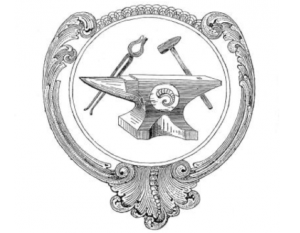In 2008, I had the privilege to restore a very large window grille made by master blacksmith Cyril Colnik. The grille belongs to the “Captain Frederick Pabst Mansion” and is situated on the northern exterior of the building. It measures 66″ x 99″. The approximate age of the grille is
“Jacob Marley“; 4″ x 5”, 16 gauge copper, wax finish. The above image is of a copper face that I completed yesterday, using the “pitch” method of repoussé. Some folks refer to this process as “high relief chasing.” In April of this year, Tom Latané of T+C Latané, Pepin, WI,
This piece, entitled “Escutcheon”, by master blacksmith Cyril Colnik (1871-1958) is one of the finest examples of repoussé that I have ever seen. It is made from 16 gauge (1/16″ thick) iron, demonstrating the elastic nature of iron. This piece, with it’s cherubs, laurels, ribbons, along with a crown with
“Candlestick 2005.” 6 1/2″ x 12″, mild steel, black Gilders Paste finish. Photo by George Lottermoser. There are different processes of repoussé, as explained in an earlier discussion here. Today we will take a closer look at the process of sinking. The below-story board shows the development of a bobeche,
French repoussé, also called “hammer and stake raising”, is one of several repoussé processes. This method utilizes several small raising hammers, that lightly strike the sheet metal over various stake forms held in a vise. Another process involves “sinking”, by using various punch-like forms to force the sheet metal into
